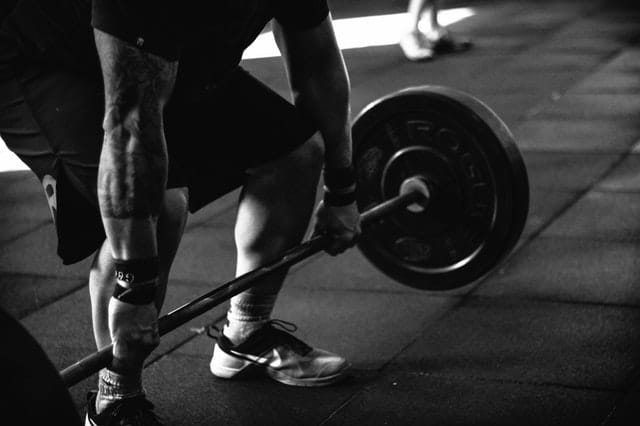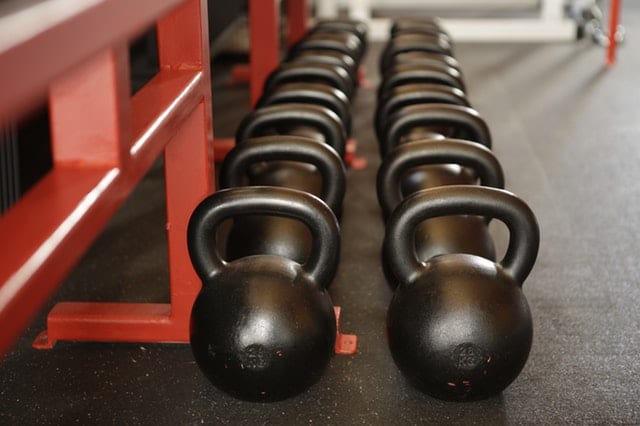
It’s that time of year, again!
Time for those dreaded New Year’s Resolutions.
How many times have you made a resolution to get something done only to fall short of your goal? I’ve been there many times as well. It can be tough to stick to a new goal, a new schedule, or a change of routine.
If you’re even a little bit like me, you tell yourself you don’t need to make a resolution. You can just change what you do at any time and make it work. I like to think that…but I think I’m just lying to myself.
So…for all of you that need to make a change this year in your fitness and exercise routines (this includes me), I decided to write a short list that will help us make good decisions on how to start our workouts and to know how much is too much.
1. What is your exercise goal? To determine this, you need to ask yourself what goal you are trying to complete? Do you want to lose weight? Do you want to gain muscle? Do you want to lower your blood pressure, improve your energy, improve your health? Are you looking at performing a race (marathon, ½ marathon, triathlon, bike a 100-miles) this year?
If you are having trouble with setting your goals, remember that you need to be very specific, set a time frame for reaching them, and break them down into shorter, more manageable stepping-stone goals. Reaching your stepping stones along the way is a great “pat-on-the-back” that can really help to motivate you to keep up the good fight.
For more on writing and setting your goals, read my blog from last New Year’s. You can read that one right HERE.
So now that you have taken a moment to consider your exercise goals for the New Year, there are several factors that also need to be considered to help you make good decisions about 1) how hard to workout, 2) how often to workout, and 3)with how much resistance.
2. How hard should you workout? The answer to this is a little tougher than just giving a single piece of advice. There are tons of hypotheses floating around about how intensely you should workout.
The American Heart Association advocates a target heart rate as follows:
Moderate Exercise – 50%-70% of age predicted HR maximum
Vigorous Exercise – 70%- 85% of age predicted HR maximum
If you are just starting out, it is recommended to stay in the lower grouping (50-70%). If you have been working out already and want to advance things, then you can workout between 70% and 85% of your age-predicted heart rate maximum. But what exactly does that mean, and how do you measure it?
You can do a simple search to get the formulas, or even have an online calculator do all the math for you. I’m going to break down two ways for you here. One is the long form, the other is the simple form.
Here is the long form (with my age used in the calculations as the example):
-
Subtract your age from 220. (220-50=170) 170 is my age-predicted maximum heart rate.
-
Subtract your resting heart rate from the remaining number (age-predicted max HR). (170-63= 107) This number is called the Heart Rate Reserve (HRR).
-
Multiply HRR by 70% (.7) then add that number to your resting heart rate number, which will be the lower limit of your workout heart rate range. 107*.7=75+63 (my resting HR)=138
-
Multiply HRR by 85% (.85) then add that number to your resting heart rate number, which will be the upper limit of your workout heart rate range. 107*.85=91+63 (my resting HR)=154
This means that for a vigorous workout, I should keep my hear rate between 138 and 154 beats per minute.
If I were just beginning, I would use 50% and 70% as my multipliers to get 107*.5=53.5 (54 bpm) and 107*.7=75 bpm. This means, after adding in my resting HR of 63, my moderate workout heart rate range would be 117 and 138 beats per minute.
Now for the simple formula to get near the same numbers…
Just use this single step arithmetic problem.
-
Take 180 and subtract your age. For me that would be 180-50= 130bpm
That’s it. No more steps…okay maybe a small step.
If you’re just starting out (or rehabing an injury), subtract 5-10 beats, and if you are an exercise fiend already, add 10-15 beats.
That means the beginner’s range (moderate) would be 120-130bpm, while the exercise fiend’s range (vigorous) would be 130-145bpm.
You can see that the first equation is more complete and most likely more accurate, but the second one gets you pretty much the same numbers really quickly. The most accurate way to get the heart rate ranges is through a metabolic stress test…but that’s a discussion for another day…or maybe not.
The easiest way to follow your pulse while you are working out is to wear a heart rate monitor. I have used Polar Pacer products for years and they are easy to use and accurate. I have tried other brands as well with mixed results on getting a reading from the chest strap, so I can really only recommend the Polar Electro products. Many Garmin and Fitbit watches now can give real-time pulse readings as well, but I haven’t found these to be as reliably accurate as a HR monitor with a chest strap.
So now you know your workout heart rate range. Time to choose your workout.
If you are doing aerobic fitness workouts, you simply need to choose your form of exercise. You could walk, use an elliptical, use a stair climber, go for a run, ride a bike…it’s up to you. But keep in mind that you do need to monitor your heart rate to get the most out of your workout. Doing too much is tough on you and often times makes people so tired or sore that they don’t want to exercise again. But the flip side is also a problem…doing too little is likely a waste of your time. And time is and unrecoverable commodity. So make your aerobic workout count by getting into the appropriate workout hear rate range.
But what if your goal is to get stronger or build more muscle?

What are your exercises goals?
How hard should you work out?
How much weight should you lift?
3. How much weight should you lift?
Again, if you search this out, you will get a very large range of answers. There is so much information out there that it gets overwhelming. So let’s try to simplify this as well.
If you are trying to build strength and muscle, you need to workout with a weight that will fatigue your muscles. For strength, that fatigue should happen in around 8-11 repetitions. To build bigger muscles, that fatigue needs to happen more quickly, in 3-7 repetitions.
Now what that means is that the higher repetitions will be with slightly lighter weights. The lower number requires heavier weights.
When you are starting out, stick with the higher number (8-11 reps). Otherwise it is likely that you will work your muscles so hard that it will cause a ton of soreness, and possibly cause excessive breakdown or tearing of the muscles you are trying to build.
But what amount of weight should you lift?
The simplest way of answering this is to figure out your 15-rep max. “What is a rep max?” you ask. It is the amount of weight that will fatigue the muscle when you lift it for the number of times specified.
This means that a 15-rep max would be the amount of weight that you can move 15-times for a specific movement or exercise…and that you could NOT lift a 16th time. Your muscle would be fatigued on the 15th repetition.
Not sure what that amount is? Start with the lightest weight you can on the equipment you are using. If you can move it 20-times, move to the next heavier weight. If you can move it 20-times, move to the next heavier weight. Repeat this process until you get to the weight you can’t move more than 15-repetitions. That’s your 15-rep max amount. (Note: There is no need to do more than 20 repetitions of a weight when searching for the 15-rep max, so don’t waste your time. Doing a weight for 45-50 reps will give you no information about what your 15-rep max is).
Use that amount of weight (15-rep max) for that particular movement/exercise, and do the exercise for 3 sets of 8-11 repetitions. Yes, I know…that sounds too easy. But here is the secret. Take SHORT rests between the sets. By short, I mean 30-seconds…not a second more. By that third set, you should be pretty darn fatigued, without having to resort to lifting super heavy weights that also bring a higher risk of injury with them.
And don’t get too complicated with the workout at first either. Begin by choosing four (4) exercises. Need help choosing? Consult a trainer or physical therapist and discuss your goals with them. They should be able to help you choose the four most effective exercises to help you in reaching your strength goals. Depending on your goals, you might need to split your routine into four upper body exercises and four lower body exercises, to be performed on different days.
If you are trying to get bigger muscles, the same rules apply, just go with an 8-10 rep max weight and lift it for 3 sets of 3-7 repetitions. Same short rests between sets. But be prepared to have a lot more muscle soreness than if you were doing the lighter weight sets described above.
4. Consistency Matters!
Unfortunately, there are no short cuts to making changes in your health. This is going to be a marathon, not a sprint. So get used to the idea that you will be making small, incremental gains that will build through the year.
Don’t think that losing a pound every week is enough? Do that math for the year…52-pounds lighter by this time next year. And losing the weight at that slow, consistent pace makes your weight lose much more likely to be permanent.
What about those bigger, stronger muscles? What if you can lift another pound every week? That’s lifting an extra 52-pounds by the end of the year. Might be possible with some movements, like squats and bench press, but don’t think that’s going to happen with a biceps curl or a dumbbell raise. But you will still see gains.
The key is to get into a good routine that you can do consistently.
How often should you exercise? Well that depends.
For aerobic workouts, you should be staying in that target range for 30-40-minutes six (6) times a week.
Yup, you read that right. Six times per week. You can do less frequently, but believe it or not, three times a week is actually more stressful on your heart. Current recommendation is at least 4-6 times per week.
For weight lifting workouts, you should be doing 2-days of resistance training on each body part. That means two days of those four-exercise-routines we just discussed. For strength gains, it only takes 40-45 repetitions per body part per week. I know, that sounds like too few, but that’s what the research shows. So 3 sets of 8 repetitions twice a week adds up to 48 repetitions/body part/week.
You guys that want to lift the heavier weights will stay lower in the number of repetitions, but don’t worry. The higher load makes up for that…and your muscles are going to need a longer time to recover even from those fewer repetitions.
By keeping your workouts in the correct range of intensity, you should not experience an excessive amount of post-workout soreness. Working at too high an intensity early in your workout experience will make you very sore. And in my experience, being that sore often is a DE-motivator for people to want to return to the gym…ever!
Summary
So to give you a brief summary…
-
Don’t just start working out without a goal in mind. Without a gaol, there is no way to stay motivated, and no way to measure your progress. Set your goals first.
-
Figure out at what level you should be working. Use the calculations above to find your heart rate range.
-
Use the gym to find your rep-max figures.
-
Set up a list of 4-exercises to do for your resistance training and stick with them. Do 3 sets of 8-11 repetitions to get stronger.
-
Be consistent! Don’t skip days…even there’s always an excuse to not work out… I tell those lies to myself as well. But ignore those lies. Set your goals, break them down into attainable levels, and keep moving forward.
Remember, there is no 5-minute fix for your weight loss, your strength gains, or your muscle building. Anyone who tells you otherwise is selling something.
This is a marathon, so pace yourself. Start small, get some early successes, and build on that momentum to reach your goals…and beyond.
Have a safe, happy, physically active and healthy New Year!
NOTE: The information in this blog is not intended to replace a one-on-one relationship with a qualified health care professional and is not intended as medical advice. It is intended as a sharing of knowledge and information based on the research and experience of the physical therapists at Lifestrength (www.Lifestrengthpt.com). We encourage you to make your own health care decisions based upon your research and in partnership with a qualified health care professional. Significant injury risk is possible if you do not follow due diligence and seek suitable professional advice about your injury.

Archives
- March 2024
- February 2024
- January 2024
- October 2023
- September 2023
- April 2023
- December 2022
- November 2022
- October 2022
- August 2022
- July 2022
- June 2022
- May 2022
- March 2022
- January 2022
- April 2021
- February 2021
- January 2021
- September 2020
- August 2020
- July 2020
- June 2020
- April 2020
- January 2020
- September 2019
- June 2019
- May 2019
